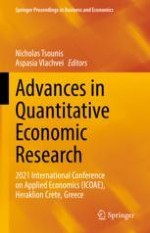2022 | OriginalPaper | Chapter
33. Strategic Agility and Economic Environment’s Friendliness-Hostility in Explaining Performance of Polish SMEs in the Phase of COVID-19 Pandemic
Authors : Tomasz Sikora, Ewa Baranowska-Prokop
Published in: Advances in Quantitative Economic Research
Publisher: Springer International Publishing
Activate our intelligent search to find suitable subject content or patents.
Select sections of text to find matching patents with Artificial Intelligence. powered by
Select sections of text to find additional relevant content using AI-assisted search. powered by
Abstract
-
In general, industry was hit less severely by lockdowns than services (most of respondents declared only “moderately” negative impact of COVID-19-related restrictions on the environment their firm operated and the relationship between the declared number of COVID-19 related consequences and market performance was weak).
-
Efficacy of government’s programs within the framework of “Anti-crisis Shield” (introduced in Poland end-March 2020) providing subsidies for enterprises (to maintain financial liquidity and employment).
-
Favorable macro-environment in which the local currency (considered as undervalued) helped both exporters making them more price-competitive and manufacturing firms operating on the local market by “insulating” them from cheaper imports.
